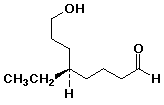![]()
![]()
![]()
McMurry, pp 281 - 284:
Problems 9.20, 22-24, 26-32, 34-40, 44, 47
1. Write complete names for each of the following:
a) 
b) 
2. Write a complete mechanism for the acid-catalyzed formation of
the cyclic acetal between acetone and cis-1,2-cyclopentanediol.
Explain why an acetal is not formed with the trans isomer.

3. Develop a synthetic sequence for 3-ethyl-3-hexanol that uses as
organic starting materials only alcohols having four carbons or fewer.

4. Explain how acetone in the presence of radioactively-labelled water
(H2O18) slowly becomes radioactive itself.
